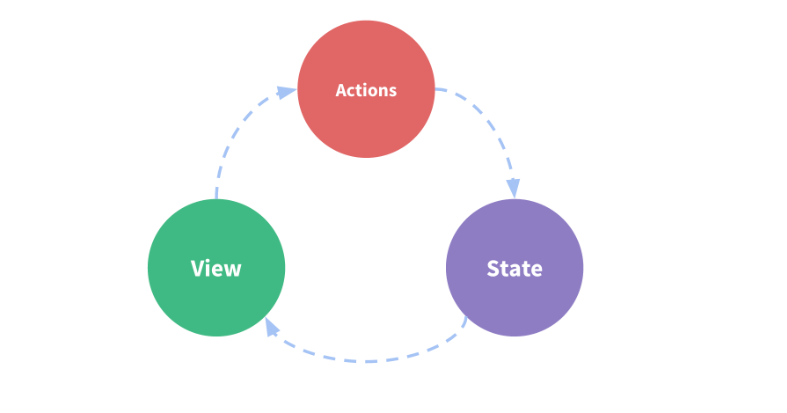vuex中mutation和action的详细区别
const store = new Vuex.Store({ state: { count: 0 }, mutations: { increment (state) { state.count++ } }, actions: { increment (context) { context.commit('increment') } } })
1、流程顺序
“相应视图—>修改State”拆分成两部分,视图触发Action,Action再触发Mutation。

2、角色定位
基于流程顺序,二者扮演不同的角色。
Mutation:专注于修改State,理论上是修改State的唯一途径。
Action:业务代码、异步请求。
3、限制
角色不同,二者有不同的限制。
Mutation:必须同步执行。
Action:可以异步,但不能直接操作State
总结:Action的方法里面可以写Ajax Mutation里面不能写Ajax
二、普通函数和箭头函数的区别
箭头函数:
let fun = () => { console.log('lalalala'); }
普通函数:
function fun() { console.log('lalla'); }
箭头函数相当于匿名函数,并且简化了函数定义。箭头函数有两种格式,一种只包含一个表达式,连{ ... }和return都省略掉了。还有一种可以包含多条语句,这时候就不能省略{ ... }和return。
(1)箭头函数是匿名函数,不能作为构造函数,不能使用new
let FunConstructor = () => { console.log('lll'); } let fc = new FunConstructor();
(2)箭头函数不绑定arguments,取而代之用rest参数...解决
function A(a){ console.log(arguments); } A(1,2,3,4,5,8); // [1, 2, 3, 4, 5, 8, callee: ƒ, Symbol(Symbol.iterator): ƒ] let B = (b)=>{ console.log(arguments); } B(2,92,32,32); // Uncaught ReferenceError: arguments is not defined let C = (...c) => { console.log(c); } C(3,82,32,11323); // [3, 82, 32, 11323]
(3)箭头函数不绑定this,会捕获其所在的上下文的this值,作为自己的this值
var obj = { a: 10, b: () => { console.log(this.a); // undefined console.log(this); // Window {postMessage: ƒ, blur: ƒ, focus: ƒ, close: ƒ, frames: Window, …} }, c: function() { console.log(this.a); // 10 console.log(this); // {a: 10, b: ƒ, c: ƒ} } } obj.b(); obj.c(); var obj = { a: 10, b: function(){ console.log(this.a); //10 }, c: function() { return ()=>{ console.log(this.a); //10 } } } obj.b(); obj.c()();
(4)箭头函数通过 call() 或 apply() 方法调用一个函数时,只传入了一个参数,对 this 并没有影响。
let obj2 = { a: 10, b: function(n) { let f = (n) => n + this.a; return f(n); }, c: function(n) { let f = (n) => n + this.a; let m = { a: 20 }; return f.call(m,n); } }; console.log(obj2.b(1)); // 11 console.log(obj2.c(1)); // 11
(5)箭头函数没有原型属性
var a = ()=>{ return 1; } function b(){ return 2; } console.log(a.prototype); // undefined console.log(b.prototype); // {constructor: ƒ}
(6)箭头函数不能当做Generator函数,不能使用yield关键字
总结:
- 箭头函数的 this 永远指向其上下文的 this ,任何方法都改变不了其指向,如 call() , bind() , apply()
- 普通函数的this指向调用它的那个对象



 浙公网安备 33010602011771号
浙公网安备 33010602011771号